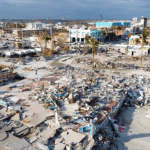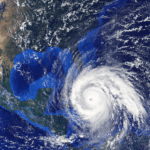Here’s how to get your remote team ready right now by using a hurricane preparedness plan template.
It’s a perfect storm.
Getting ready for hurricane season may be a bit complicated for businesses this year because of the COVID-19 outbreak.
Not only do you have to consider how a natural disaster could disrupt the office, but you must also think about how it would affect your employees working from home.
You realize it’s crucial to keep your business’s information technology (IT) up and running in an emergency—no matter where your workers are located. The good news is it’s not too late to prepare for a worst-case scenario.
What Should I Include in My Hurricane Preparedness Plan?
You want to make sure your business can get back up to speed as soon as the storm passes. Your hurricane preparedness plan should involve areas of assessment, communication, and drill implementation—as well as address financial and legal concerns (plus outside partners).
Assessment
You should start by evaluating the status and needs of your people, assets, and facilities. You need to know where everyone is, what equipment they have, and what they will need to function in the event of a hurricane.
Ask yourself questions such as:
- Can your employees work from home without gas, power, water, internet, or telecommunications?
- Can your employees work from home without computers, copiers, fax machines, files, inventory, or special equipment?
- Will your employees be able to continue working if their homes are damaged?
Next, ensure all necessary emergency equipment is on hand and serviceable. An internet connection and electricity are likely the two most important factors in your employees’ ability to work from home. Consider whether you need to invest in portable generators and mobile hotspot access.
Lastly, verify solid plans exist for securing sensitive assets, data, and equipment. Determine whether you have safeguards in place to protect against network hacking as well as physical theft of your devices from employees’ homes.
Communication
During an emergency, you have to be able to communicate with your team. Make sure you have updated contact information on all of your employees, vendors, etc. in both digital and print versions. They should have various ways to contact you as well. It’s also good to have a communication tree system in place to pass along messages and make sure everyone is included and accounted for.
You should conduct an employee awareness campaign that educates your team about the safest response before, during, and after a hurricane. This could be done as a webinar or sent out over email. Discuss topics like shelter locations, emergency communication plans and policies, when to evacuate (when advised), seeking higher ground for flash flooding, and avoiding entering floodwaters.
Confirm your team has access to hurricane preparedness handouts and other relevant resources that will help them manage during a natural disaster. They should also be familiar and up to date on any company policies that are relevant to emergencies.
Drill Implementation
Conducting drills will look quite different than the norm this time around because your team is scattered in different locations and not together in one building. Nevertheless, you should still create emergency response teams and lists that identify clear roles and responsibilities for each person so they can be activated if needed.
You also must clearly define a timeline for the execution of your plan in relation to landfall. Decide if your plan will go into effect before the eye of the storm reaches your area, as it’s making landfall, or after it’s passed through the region. Put together, in order, the series of steps that need to be taken from the time the hurricane hits until the all-clear is given.
Finally, rehearse! Create scenarios where your emergency response teams and preparedness plan are put into action. Have your employees use an alternate power source. See if they can connect to and work off of a mobile hotspot. Run through situations where a communication tree system must be used to get in touch and check everyone’s welfare.
Financial/Legal
You should take a look at all of your existing contracts, policies, and agreements for any mention of hurricane response and recovery. Be aware of any obligations you may have to maintain with customers, vendors, suppliers, and other business partners in the event of an emergency.
Financially, assess whether you will be able to meet payroll if your business income is interrupted by a hurricane. If so, estimate how long that could last before the money runs out. Research the possibility of applying for emergency loans, disaster assistance funds, and other financial assistance that could help you support your team.
Keep the three Ps in mind: paper, pictures, and property:
- If your employees are keeping important documents in their homes, make sure those files are protected or copies are stored securely online.
- Have your team take pictures of their equipment for potential insurance claims in case their device gets damaged.
- Make a list of the makes, models, and serial numbers of your staff’s computers, tablets, and phones in case you need to prove that equipment is company property.
Outside Partners
If you employ contractors as well as full-time staff, don’t forget to include the freelancers in all of your plans, policies, and procedures, especially if they work remotely and use your equipment.
It wouldn’t hurt to get in touch with your suppliers before a storm hits to go over their emergency plans, too, and understand how their response may affect your business—and vice versa.
Do a little foreshadowing and evaluate the potential impact a hurricane could have on your clients and customer service capabilities to get ahead of critical issues and possible problem areas.
How to Prepare Your Remote Team for Hurricane Season
Now you know how to get your work-from-home employees ready for the season by using a hurricane preparedness plan template.
By focusing on areas of assessment, communication, drill implementation, financial and legal concerns, and outside partners, you’ll be able to take care of your team whether they are in a cubicle or at a kitchen table.
You can find a wealth of resources on hurricane preparedness in the WheelHouse IT Storm Resource Center. Feel free to use our hurricane preparation and response checklist, check out our hurricane communication templates, or search for other information that will help you weather the storm and get back to business.














